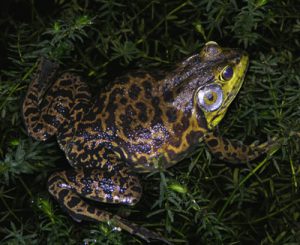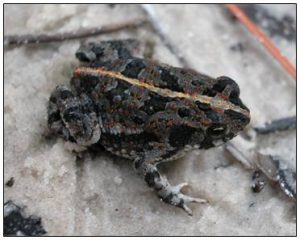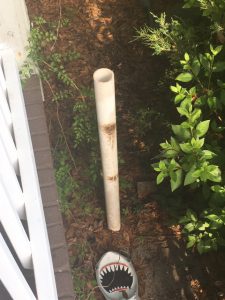Over the weekend one of our followers found a barking treefrog exploring their yard. This was great for the kids and a great teaching moment. They wanted to know about this frog and, because it is supposed to rain today (in Pensacola), it seemed like a good subject for Lesson 2 of Wildlife.
So, let’s go frog hunting!
Frogs, of course, are amphibians. This means they lay what are called non-cledoic eggs (eggs with no shells). Because there are no shells, these eggs must be laid in water. So, when it rains, frogs get going – it is time to find water and lay some eggs! Hopefully we will get rain today and MAYBE you find some in your yard afterwards.

Photo: University of Florida Wildlife.
In the Florida panhandle, there are 24 different kinds of frogs and toads. There are two additional invasive ones that have been reported. Half of them (13) are what we call treefrogs. Treefrogs can be distinguished from other frogs in having large toe pads. These toe pads have grooves that act like velcro and allow them to “stick” to almost any surface. They spend their daytime hours hiding in bushes and trees until the sun sets. They then come out to hunt bugs. A good place to find one would be on the wall of your house, near a bush, where an outdoor light is on to attract bugs. Actually, to survey for an invasive treefrog (the Cuban Treefrog) many will place a 3’ section of PVC pipe in the ground in an area like this (see photo). The treefrogs feel safe in these during the daylight. One of our Florida Master Naturalist, Emogene Johnson, has several of these she has painted to match her garden. She has had as many as 14 treefrogs living in them at one time. She has been looking for the Cuban Treefrog but has had great fun finding all of the native treefrogs while doing so (FYI – she has not found a Cuban treefrog yet – good).
What kind of treefrog you have will depend on what type of skin covering they have.
Eight have smooth skin – no warts or bumps. The most common of these is the small Green Treefrog. This little guy is about 1-2” long, a light green color, with a white stripe running down it’s side. It prefers to live near permanent water features. Others among the “smooth skinned treefrogs” include – Squirrel, Pine Woods, Cope’s Gray, Bird Voice, Spring Peeper, Ornate Chorus, and the Pine Barrens treefrog. Some of these have beautiful colorings on them and some have specific habitat requirements and may not be in your yard.
There are two local treefrogs that have granular backs. These are very small bumps that make them look, and feel, like sandpaper. Both, the Barking Treefrog and the Southern Chorus Frog, prefer to lay their eggs in ponds with no fish – for good reason! Both frogs have brown spots on their back, but the southern chorus frog’s are more aligned and it has a pointed snout.
There are three treefrogs that have warty skin – bumps larger than the “granular” ones mentioned above. Two of these are native – the Eastern and Southern Cricket Frogs. Both have a triangle pattern between their eyes and like to be near rivers. The third is an invasive species that has been reported here, but we do not think it is established – this is the Cuban Treefrog. In addition to having warty skin, this is a large treefrog reaching almost 6” long!
“True Frogs” are much larger than the treefrogs, lack the toe pads, have smooth bodies, and have well developed hind webbed feet for swimming. There are seven different species you might find here. Four of these have two folds of skin, forming ridges, along their backs. These include the Bronze Frog, the Gopher Frog, the common Southern Leopard Frog, and the rare Florida Bog Frog. The Florida Bog frog has only been reported from the western panhandle and primarily on Eglin AFB.

Photo: Dr. Steve Johnson UF
There are three true frogs who lack the skin ridges on their backs: The Bull Frog, the Pig Frog, and the River Frog. These are large frogs reaching about 6” in length and weighing up to a pound! Their large legs are a popular food item in the south and frog gigging is a popular recreational activity with some. They prefer large permanent bodies of water and favor swamps.
I do not think you will find any of the “true frogs” in your PVC pipe!
However, what you MIGHT find are one of the three species of toads that live here.

Photo: USGS
Toads differ from frogs in the lack of webbing in the feet. They can swim, but they are not good at it and prefer to live beneath the leaves and logs of your yard. They have much shorter hind legs, warty-bumpy skin, and two enlarged poison glands on their shoulders. This is a good place to discuss venomous versus poisonous. Venomous creatures produce a toxin that they inject into you, such as snakes and spiders. Poisonous creatures can produce a toxins but only secrete them on their skins to deter you from eating them. None of the local toads are deadly, but they will produce a foul smelling/tasting poison when handled.

Photo: Dr. Kenneth Krysko UF
We have three types of toads you may find. The Oak Toad is a small toad common in neighborhoods where the soil is dry and sandy. I usually find them in wooded areas. They are small, about 1” long, and have a distinct white/beige colored stripe running down the middle of their backs. The Southern Toad is VERY common. I have found as many as 22 in my yard after a rain searching for a pool to breed in. MAYBE YOU WILL THIS WEEK! They are larger than the oak toad and do not have the white stripe. Fowlers Toad is hard to tell from the southern toad. One difference is the number of warts/spot on their backs. Fowler’s will have 3 or more, the southern toad will have 1 or 2.
ACTIVITY
NOW IT IS TIME TO FIND SOME FROGS!
Hopefully it will rain today – and hopefully these frogs will come out from their drought hiding places looking for water. There are couple of ways to do this.
1) Search your yard. They are not going to be in the open (unless they are moving towards a water source). You’ll have to look under things, in leaf piles, garden mulch, under logs and pots, things like this. They are going to be moving more at night – so a flashlight hunt can be fun.
2) Wait until dark and search the side of your house with a flashlight. You could also turn on a porch light to draw in the bugs. If treefrogs are around, they will eventually settle on your wall, door, or window.
3) I have found treefrogs hiding in the center of bromeliads and on large leafed plants like elephant ears and palms.
4) Treefrogs will also hide during the day inside things like – butterfly and bird houses, clay flowerpots, and the PVC pipes I mentioned earlier.

Photo: Rick O’Connor

Photo: Rick O’Connor
IF YOU DO NOT FIND ONE TODAY… MAYBE TOMORROW
GOOD LUCK AND HAVE FUN
OH! … WASH YOUR HANDS AFTER HANDLING ANY FROG OR TOAD… now go have fun
 0
0
